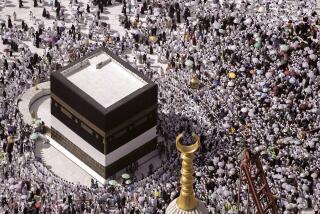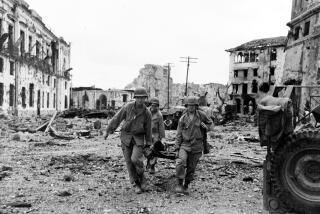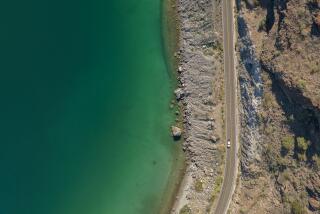Seeing Red on a Journey to Historic Malacca : Malaysian City Is a Colorful Mecca of Shoppers and a Link to Centuries Past
MALACCA, Malaysia — Tour bus PZ152 has made it across the half-mile causeway, from the gleaming office towers and electronics shops of the island nation of Singapore to the agrarian Malaysian mainland, in just under an hour. Behind lie the mob scenes at either end of the causeway: exit check leaving Singapore, entrance check coming into Malaysia, thousands of Singaporeans pressing to cross the only land route off their island onto the Southeast Asian mainland, if only for a day. Because it’s Sunday, the crowd far exceeds weekday numbers.
Now, the driver of PZ152, a Singaporean Chinese who favors cowboy boots and aviator sunglasses, reluctantly ejects his Dolly Parton tape. Our Malaysian guide, a young Tamil woman whose ancestors probably emigrated from India as agricultural workers, picks up the microphone. “Our destination today is the historic city of Malacca,” she begins, and I settle happily into my window seat.
At last, Malacca, if only for a day.
My idea of Malacca came from photographs I’d seen, curious juxtapositions of a 17th-Century Dutch stadthuys , or statehouse; a fountain honoring Queen Victoria; a Chinese temple with glass and porcelain animals capering on the roof; a Portuguese Christian church that would be at home in Brazil, and an 18th-Century mosque with a three-tiered Sumatran roof. The pictures had seemed flooded with red: red church, reddish stadthuys , red temple doors, red clock tower.
Here was an Asian city that seemed to have been put together from the jumbled leftovers of some overreaching theme park. I wanted to see it for myself, but over the years several plans had fallen through. This spring I had arrived for a stay in Singapore determined to take a look at Malacca.
For a time, it seemed that even one day would be impossible. Tour operators had canceled their trips into Malaysia until a jurisdictional dispute between Singaporean and Malaysian tour guides could be settled. Then the wonder-working concierge at Singapore’s Goodwood Park Hotel found that one last tour--this one--would operate to Malacca. He booked me a seat.
With about 20 passengers aboard, the small bus made its way through the teeming city of Johore Bahru--universally known as J.B. Most of the crowds on the causeway were headed for J.B. to shop. Devaluation of the Malaysian ringgit against Singapore’s dollar has made this city’s shops and street markets a magnet for shoppers from the island.
PZ152 pulled free of the downtown jam and eventually bore left along the flat waters of the Strait of Malacca, which lies between the Malay Peninsula and the Indonesian island of Sumatra. (The causeway connecting Singapore with Malaysia is over the narrow and shallow Johore Strait.) “The city of Malacca is situated something like 248 kilometers away,” the guide announced. “Nonstop driving we should be there in something like 3 1/2 hours, hmmm? Or close to four hours?”
The rhythm of her English was keeping me a few words behind her, and I thought I’d got the numbers wrong. But it quickly became apparent that a trip of about 154 miles could take four hours, more for us since we were making a rest stop en route. We were following a two-lane highway clogged with traffic: automobiles, transport trucks, buzzing motorbikes with father driving, mother hanging on behind, toddler bracketed between.
Still, four hours on this highway would be more fun than four hours on I-95. In the towns, traditional shop houses--shops on ground level, living quarters above--lined the roadside. Blue or green doors and Chinese Chippendale trims decorated the older houses; window air conditioners jutted from some newer ones.
We passed densely planted rubber plantations with dusty rubber tappers’ villages close by. According to the guide, that was for the convenience of the tappers, most of whom are women, enabling them to get home quickly after work to care for their children.
She was an enthusiastic publicist for her country. The British brought the first 11 rubber trees from Brazil in the late 1800s, she said. “Today, I am proud to say that 42% of the world’s rubber comes from Malaysia.”
The guide was also a stout defender of palm oil, another product in which Malaysia leads world production. She picked up her microphone to explain that recent talk about palm oil being bad for you is a malicious lie spread by the makers of less desirable sorts of oil.
We traveled for miles through groves of the vindicated trees, their black shade sliced by daggers of sunlight. I remembered scenes from World War II films, and from “A Town Like Alice” on PBS, where English and Dutch women were herded barefoot along a road like this, through the palm groves and rubber trees.
Although Malaysia has been completely independent since 1957, its strategic location attracted invaders for centuries.
In the late 14th Century, about 500 years before Stamford Raffles founded the British colony of Singapore, a Sumatran prince established a city he called Melaka (the proper Malaysian spelling of the city even today). It became a rich Muslim port whose harbor was filled with the ships of Arab, Indian, Siamese and Chinese spice and silk traders.
In the 14th Century, agreements between the sultan and the Ming emperor of China brought to Malacca the Chinese immigrants who became known as the Straits Chinese.
The 16th Century brought Portuguese rulers who were replaced by the Dutch in the mid-17th. The British took power in the early 19th Century and held it until Malaysian independence in 1957, except for nearly four years of Japanese occupation during World War II.
Reminders of each of these periods--and fondness for red--make Malacca one of Asia’s most colorful cities.
By now, we’d had our rest stop, at a place on the map called Kampung Macap, where PZ152 pulled into the Aw Pottery Works, a traditional tourist stop. The Aws, it would appear, are perfectionists. They have smashed tens of thousands of pieces that failed to satisfy them. Bits of teacups and rice bowls, saucers and plates are embedded in the walls, floors, table tops and even toilet fixtures of the Pottery Works.
The mad mosaics were everywhere, shaping words, forming rosettes and daisies, encrusting buildings. Exterior walls were constructed of imperfectly glazed breeze blocks.
Inside the “SHOWROOM”--the word itself spelled in blue tile on a wall outside--were thousands of vases, pots, jardinieres, bowls and teapots that had managed to pass the test. In celadon green, yellows, reds, and blue-and-white patterns, the Aw wares were stacked and shelved from floor to ceiling.
There are great bargains to be had. The rest stop was brief and I was still translating from ringgit into Singapore dollars and back to U.S. currency when it was time to board the bus. Too late, I worked it out that a beautifully patterned vase big enough to stand on the floor would have cost just $11.11.
Finally, we were approaching Malacca, past typical Malaysian country houses built on stilts, with broad steps to a veranda.
In the city at last, touring must wait for a buffet lunch at a high-rise hotel. The meal was no hardship; Malaysian cuisine with its complex mixtures of spices and other flavoring elements is glorious. But time was short and points of interest many. If I had it to do again, I’d leave the group at lunch and hit the street early.
The street I’d hit would be Jalan Hong Jabat, formerly Jonker Street, in Old Malacca, which is lined with inviting antique shops. Inside are old Chinese porcelains and Indian brasses, Dutch cupboards and Chinese carved rosewood furniture, gold filigree and repousse jewelry. But there was only time to stare through open doors as the guide hurried us to the Cheng Hoon Teng Temple.
Taoism, Confucianism and Buddhism have coexisted in this building for centuries. The temple was founded in 1645; construction of the sprawling complex continued until the early 19th Century.
Artisans from South China built the temple, using traditional methods and materials. Eaves and ridges of the roof are decorated with mythical creatures made from glass and porcelain, and the prayer rooms and altars are decorated with beautiful lacquerwork and wood carving.
Hot and sluggish after too much delicious gulai udang --a rich prawn coconut-milk curry with lime and coriander--our group moved through temple wings that surround a courtyard. We examined depictions of the life of Buddha, the simple altar devoted to Confucius, and the bronze statue of Kwan Yin, goddess of mercy, healer of the sick and calmer of the distressed, who in this depiction bears a marked resemblance to the mature Queen Victoria.
The temple was full of life. Malaccans were bowing, chanting, lighting joss sticks, arranging altar tables and kneeling before altars, their knees cushioned against the worn tile floors by small square pads. We bus people aroused no curiosity, no dismay. After nearly 350 years, the Cheng Hoon Teng seems accustomed to strangers.
For the next hour, we moved through the streets of Malacca’s Chinatown, lined with shop houses whose upper floors sported frescoes, brightly painted shutters, patterned tiles and mosaic designs. We inspected the pagoda-shaped minaret and Corinthian columns of the Kampung Keling Mosque and the 18th-Century Hindu temple that serves the descendants of the earliest Indian traders.
As the afternoon lengthened, our tireless leader urged us laggards across a bridge and onto the Dutch Square, site of the Queen Victoria Fountain, Malacca Clock Tower, Christ Church and the Stadthuys. The red buildings surrounded a central garden planted with marigolds, the whole of it creating the amazing post-card scene that had lured me there.
The Stadthuys , reputedly the oldest Dutch building in Asia, was completed during the 1650s to house the Dutch government. With its thick walls, heavy wooden doors and windows with wrought-iron hinges, it’s now the home of the Malacca Historical and Literary Museums. Dutch, Portuguese, Chinese and Malay antiques are displayed, among them opulent bridal costumes and porcelains.
The Queen Victoria Fountain, a scepter rising from a crown-shaped basin, was built in 1904 “in memory of a great Queen.” The Tan Beng Swee Clock Tower was erected in 1886 by a grandson in memory of his grandfather. When its original English clock failed after 96 years, it was replaced by Japanese works. The choice angered Malaccans who remembered that severed heads of townspeople had hung in the square during the Japanese occupation.
Before leaving Dutch Square, I slipped into Christ Church, the surpassingly lovely, mid-18th-Century church built by the Dutch to commemorate 100 years in Malacca. The equatorial sun soaked into exterior walls as red as the cover of a new hymnal. Inside the church, it was dark and cool. I rested in a 200-year-old carved pew with a wicker seat, near a cenotaph in memory of Mrs. Mary Betty “who departed this life September 20, 1800, aged 30 years.”
By now the bus was in the square, loading its dripping passengers for the final stop, on Parameswara Road at the foot of St. Paul’s Hill. At the end of a climb made harder by heat and fatigue was the Porta de Santiago. This last remaining ruin of a 16th-Century Portuguese fortress adjoins St. Paul’s Church, built in 1521 by a Portuguese captain. Father Francis Xavier preached there in 1545.
When we climbed onto the bus again, there were still important parts of Malacca we hadn’t seen, notably the Malay neighborhood built in traditional kampung (compound) style, and the Portuguese settlement.
But we were out of time. The guide put down her microphone and the cowboy driver punched in a Willie Nelson tape. Despite the volume, I dozed. Once I woke to see milky mists rising like ghosts from the creases of a rubber plantation in the hills. Once, I saw a night market illuminated by lantern light. There was a sultan’s palace on a hill. And it was not long before PZ152 recrossed the causeway to Singapore.
GUIDEBOOK: The Road to Malacca
Getting there: From Singapore, numerous tour companies operate similar one-day trips to Malacca, among them Gray Line, Tour East and RMG Tours, through which my trip was booked. The cost is about $45 and includes travel, tour and lunch. Reservations can be made through hotel concierges. Passports must be more than six months from expiration.
In order to avoid heavy traffic, try not to go on a weekend. All buses are air-conditioned, but larger buses are likely to be more comfortable for the long ride. If you carry along a lunch or snack, you’ll have more time for sightseeing and shopping.
Tour East offers optional extensions that permit visitors to remain in Malacca for one or two nights, a desirable alternative to the eight hours that day-trippers must spend on the road. Another format available from Gray Line is a three- or four-day tour to Malacca and Kuala Lumpur, with a night in each.
For more information: Contact the Malaysian Tourist Information Center, 818 West 7th St., Los Angeles 90017, (213) 689-9702.
More to Read
Sign up for The Wild
We’ll help you find the best places to hike, bike and run, as well as the perfect silent spots for meditation and yoga.
You may occasionally receive promotional content from the Los Angeles Times.






